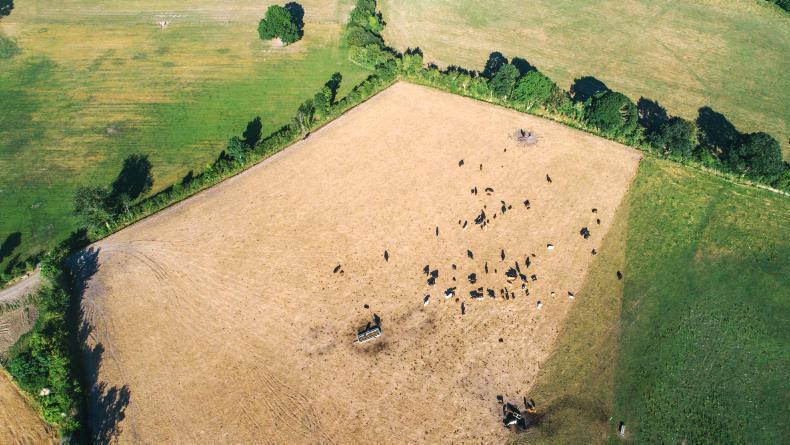This week, average growth rates across the country continued to fall as drought takes a tight hold of grass growth. On our measuring farms, the average growth rate is 35kg DM/ha/day, however massive variances in growth rates between farms remain.
What was originally seen as a dry spell that would have to be borne with through gritted teeth, is now turning into a prolonged drought that many farmers are beginning to struggle with. The most worrying aspect now is that there is still no end in sight, as Met Éireann forecasts the current spell of weather to persist well into next week.
A high majority of farms are now buffer-feeding stock at grass in an effort to hold the rotation length and to avoid running out of whatever strong covers that remain.
The problem here is that much of what is being fed now is fodder that is needed for the winter – especially as stocks are at their lowest level in years. As this is the case, the best strategy now is to begin planning long term.
Stock that was originally earmarked for housing may have to be sold.
If this is the case, it will be necessary to introduce concentrates to supplement a lack of grass.
Cows can be scanned 30 days after breeding stops. Again, scanning cows will immediately identify extra cows for culling and again the question of ‘how long do I need to keep these animals?’ must be asked.
While dietary stress, caused by very rapid changes in diet, can lead to an increased risk of embryo losses, cows in calf certainly can be restricted slightly more now. Best practice here is to ensure that calves are creep-grazing in front of their mothers and in turn these cows can be held back, with perhaps a poorer-quality bale of silage or hay to further delay rotation.
Many farmers are also choosing to graze second-cut silage ground. These are covers not strong enough to cut, but they are actually reducing as heat stress forces them into a seeding stage.
The hope is to graze these fields and then take up a second cut when conditions allow.


Offaly
System: Suckler/calf to steer beef
Soil type: Free-draining loam
Farm cover (kg DM/ha) 336
Demand (kg DM/ha/day) 29
Growth (kg DM/ha/day) 24
I’m not one to moan about the weather, but the conditions this year have just been bizarre. Grass is now extremely tight as demand has surpassed growth. My store cattle are my priority and I’m pushing them hard so they will be fit to kill off grass in the back-end. I’m grazing to the clay, but they are going into nice covers of around 1,400kg DM/ha. The problem is I’m running out of those nice covers now.
Cows and calves are grazing poorer ground behind the yard at home. The calves I reared this spring are grazing strong grass which probably should have been cut as surplus bales, but I have nothing else for them.
With no rain forecast for the foreseeable future, I’d be lying if I said I wasn’t worried. Close to 50 strong cattle and cull cows will get 6kg of meal and a bale of silage in a sacrifice paddock once they finish the grass in front of them. I plan to offload any passengers as soon as possible, to alleviate pressure.

Carlow
System: Suckler to steer beef
Soil type: Free-draining
Farm cover (kg DM/ha) 343
Demand (kg DM/ha/day) 32
Growth (kg DM/ha/day) 24
Like the majority of farmers in the area, this continued dry spell is really taking its toll on the farm. There has been little or no growth over the past couple of weeks and grass is starting to run out quickly. I have been supplementing cows with silage for the last three weeks and recently I had to start supplementing the yearlings too. I have decided to start grazing the ground I had closed for second-cut silage. I closed this ground in the first week of June but since then it never really kicked off and there is a low cover of stressed grass on it. I think the best thing to do is graze it off, fertilise it again when the rain does come and hopefully I will get a second cut out of it at a later stage.
I slaughtered a group of steers and heifers which I had been meal-feeding at grass over the past few weeks to try and reduce my grass demand.

Newford Herd, Athenry
System: Suckler to steer finish
Soil type: Mixed
Farm cover (kg DM/ha) 471
Demand (kg DM/ha/day) 54
Growth (kg DM/ha/day) 29
We are no different than anyone else down here this week. Every group is getting silage at this stage as we try to maintain the rotation length and hold on to covers as long as possible. We have four groups of stock in total, two bunches of cows and calves and two of finishing stock. I only made 80 surplus bales this year so with all these groups to feed, it’s not going to last long. It’s a crying shame to be using the best silage made already.
This week I put long, horse-fencing stakes in the ground to lift up the wire and to allow the calves to creep ahead of the cows. I also put a trough with a few handfuls of meal outside the lifted fence to encourage them to go under. I find the cows are quite content staying back once they have silage to pick at and plenty of water.
We have just finished breeding too. This year we are 100% AI. Our policy was to allow every cow three services and after that empty cows will be culled.

Cork
System: Suckler/calf to bull beef
Soil type: Relatively dry
Farm cover (kg DM/ha) 333
Demand (kg DM/ha/day) 42
Growth (kg DM/ha/day) 13
Grass growth has been poor over the past few weeks, but this week it has completely stopped as ground gets more burned by the hour. Currently, I have only one week’s grass ahead of me. I have held up cows and calves in one field, in the hope of giving the ground a chance to grow by increasing the rotation length. These are getting two bales of silage per day. The water intake of these animals has risen dramatically in this weather and due to feeding silage, so it is vital to make sure these animals have a good water supply. To further reduce demand and slow down grass intake, I have introduced the weanling heifers and bulls to 2k/head of concentrates. I weighed all the calves about two weeks ago and am very happy with the daily gain of both my own calves and the bought-in calves. I plan on scanning the cows as soon as possible to identify the cows not in calf and I will sell any empty cow immediately to further reduce demand.







 This is a subscriber-only article
This is a subscriber-only article










SHARING OPTIONS: